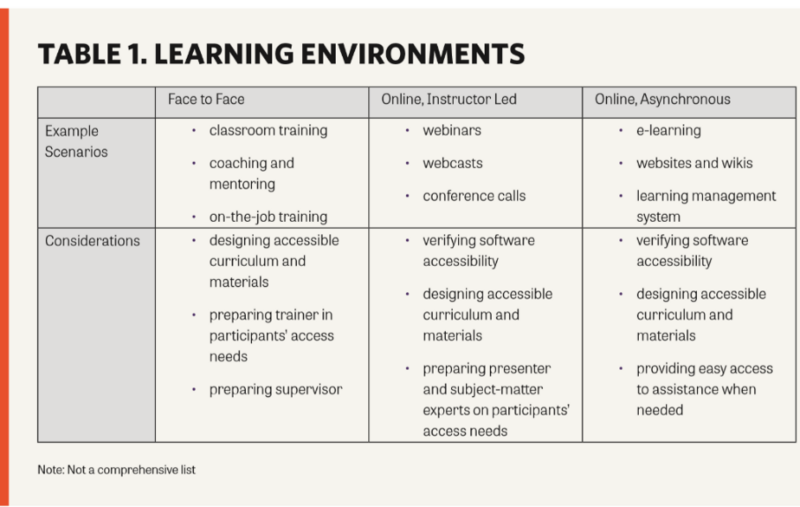ATD Blog
No Learner Left Behind
Mon Mar 26 2018

Roughly 19 percent of the U.S. population has a disability of some sort, and some people have more than one. As an L&D professional, you want the course materials you create to be available to all learners. Whether you’re designing an online course, instructor-led classroom, or any other format, you need to make sure that your audience can access the content. Your audience can be anyone—an employee, a partner, a vendor, or a customer. And any of these people may have a vision or hearing disability, a physical disability, movement disorder or learning disability.
Not only do you want to reach your learners where they are, in many cases, you are required to do so by law. Section 508 of the Rehabilitation Act and the Americans with Disabilities Act requires that information technology be available to all individuals, regardless of disability. L&D professionals need to be aware of these laws when preparing their training materials as well as any information that is available in the public domain.
The Design Process
The time to begin thinking about accessibility is not when you are testing your course in the pilot phase. Instead, you need to integrate it into the early stages of the design process. Keeping accessibility in mind from the start will save you time and money. As the U.S. Department of Health and Human Services emphasizes: “It is much easier to create content that is accessible in the first place (bake it in), than to remediate content after the fact (bolt it on).” To design accessible learning, begin with a perspective of understanding, a positive mindset for Inclusion.
If you look at learning and development programs that are designed and delivered in organizations around the world, you can break down everything we do into three basic categories of learning environments:
face to face
online, instructor led
online, asynchronous.
Table 1 (from the TD at Work, “Designing Section 508 Compliant Learning”) provides example scenarios relating to program design and development considerations for each of those three categories.

Regardless of disability type, the accessibility needs of learners fall into these four major categories:
auditory
visual
physical
cognitive.
Table 2 provides disability types aligned the four categories of access needs. People with the disabilities listed tend to have access needs that fall into four categories. The specific accommodations needed will vary, based on individual needs.
Table 2: Access Needs for People With Disabilities
Auditory | Visual | Physical | Cognitive |
Deaf Hard of hearing Hearing impaired Cognitive processing ADHD | Blind Limited vision Dyslexia Color blind Cognitive processing ADHD | Mobility Ambulatory Motor coordination Hand/eye coordination | Ability to focus Learning differences Cognitive processing ADHD Stress or anxiety |
An important thing to notice is that there is overlap between access needs and disability type; as a result, the design process should focus on the access needs not the type of disability. For example, someone who is deaf or hard of hearing obviously has an auditory impairment; however, some learning disabilities also have an auditory processing component. Similarly, someone who is blind or has limited vision has a visual impairment, and some learning disabilities (such as dyslexia) have a visual processing aspect that would be accommodated in a very similar way as someone with a visual impairment. In a nutshell, accommodating one learning need will benefit people with more than one type of disability. For example, you may find that accommodating different learning needs also benefits individuals with language or literacy needs (such as closed captioning aiding people who have English as a second language). And people without any special needs also may appreciate the additional supports. |
Pairing Learning Environments with Access Needs
Let’s put it all together now. Table 3 integrates the learning environment with access needs and provides a fairly comprehensive look at possible instructional design methodologies that will address accessibility needs of the learner.
Table 3: Learning Environments and Access to Learning
Face to Face | Online, Instructor-Led | Online, Asynchronous | |
Auditory Access | Sign Language (ASL) interpretation Provide hard and/or soft copy of materials Ensure that all course videos you use, have closed captioning Provide specific written directions for learning activities and worksheets | Use LIVE closed captioning of the webinar Provide transcripts of live presentation and dialogue Ensure that all course videos you use, have closed captioning Provide transcripts of course videos Develop a script prior to session if possible | Closed captioning of all spoken words Ensure that all course videos you use, have closed captioning and/or transcriptions Review all auditory directions provided in the course, and ensure that the same directions are provided visually |
Visual Access | Provide hard and/or soft copy of materials prior to class Create clear verbal description of all photos and graphics (capture the context) Examine color choice and contrast of slides and graphics Be very specific when providing directions about breaks, lunches, activities, restrooms, etc. | Ensure screen reader can access “live chat” stream Provide clear verbal description of photos, graphics and video Use “Alt-tabs” on photos and graphics for screen reader access Webinar software must be accessible via keystroke Examine color choice and contrast of slides, graphics and other visual images | All content must be accessible via keystroke; mouse-enabled, drag & drop doesn’t work Use “Alt-tabs” on photos and graphics for screen reader access Review all visual directions provided in the course, and ensure that the same directions are provided auditorily Test the program to ensure it really is accessible |
Physical Access | Ensure that there is physical access to the training location If there is an activity that requires physical movement, inquire about ideas for inclusion Never assume they can’t participate Allow extra time for individual activities, worksheets and assignments | Vary methodology for participation – live chat and vocal discussions Consider movement limitations, and allow extra time for transition to breakout rooms Allow extra time for individual activities, worksheets and assignments Never assume they can’t participate | Remove time based restrictions in the course Consider enabling both keystroke and mouse enabled content (such as drag & drop) to allow for multiple ways for access Provide both audio and visual directions Include closed captioning to provide additional access |
Cognitive Access | Remember that cognitive and psychological needs are invisible and you may not be aware of a need for accommodations Be flexible to requests for variation if possible Variety is key – all of the above methodologies for access, can apply here Allow extra time for individual activities, worksheets and assignments | Ensure that all directions and expectations are clearly communicated Be flexible to requests for variation if possible Variety is key – all of the above methodologies for access, can apply here – especially auditory and visual Allow extra time for individual activities, worksheets and assignments | Remove time based restrictions in the course Consider enabling both keystroke and mouse enabled content (such as drag & drop) to allow for multiple ways for access Provide both audio and visual directions Include closed captioning to provide additional access |
Of course, this is not comprehensive; however, it does provide you with a fantastic one-page overview that captures the essence of integrating design and need. |
Perhaps you noticed that some of the design and development ideas focus on preparing the people, not just instructional design and technology. When working to create a culture of inclusion (not just compliance), the Supervisor or Manager the employee reports to for on-the-job training must be educated on the legal requirements, yet also must be able to respond to the very real needs of the end users with disabilities.
In many ways, providing (and designing) better access to information and learning, is similar to what happened when physical and architectural changes were made to buildings and sidewalks in the early 1990s. After the passage of the ADA, the unexpected benefit of adding physical curb cuts at intersections for people who use wheelchairs, was in fact a huge benefit for delivery personnel with wheeled hand-carts as well as parents with children in strollers.
Disability laws have been in development for many years and have provided the foundation and framework that creates a better life for people with disabilities. In many ways, these laws represent an awakening in the United States and around the world; an awakening to the rights and needs of a population of people who have previously been marginalized. The spirit of these laws is to truly provide access to information, opportunity and a better way of life.
For a deep dive into this topic, join me at the ATD 2018 International Conference & Expo for the session: No Learner Left Behind: Designing and Delivering Accessible Learning Programs.
